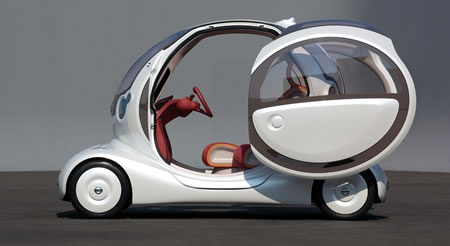Ten Cool Concept Cars
Mercedes-Benz Bionic
The bionic concept car introduced by Mercedes-Benz is designed based on various phenomena in nature. In this series of cars, DaimlerChrysler applies advanced diesel technology to daily-use functions and practical models.
Bionics - the combination of biological science and technology - is a newly developed research field but has already made breakthrough progress in many aspects. Nature inspires people with "wild ideas" in many ways, such as producing high-strength materials, wear-resistant surfaces, dirt-resistant coatings, and practical Velcro (a type of nylon hook-and-loop fastener), etc.
Many inventions are more or less accidentally inspired by the animal and plant world. For Mercedes-Benz's first bionic car, the engineers from the Mercedes-Benz Technology Center and the DaimlerChrysler Research Center (MTC) attempted to design a car model that is aerodynamic, safe, spacious, and environmentally friendly. They were dedicated to finding an example in nature with a form structure similar to their design concept. In other words, it was not just about methods of detail but the first thorough transformation from nature to technology.
The design of the bionic car requires teamwork; biologists, bionics experts, and automotive researchers from different research fields focus on "expeditions" in the animal kingdom and soon made significant discoveries by concentrating on the deep-water world. Animals like sharks and dolphins, as the fastest and strongest swimmers in the ocean, are actually not the most ideal for the researchers' needs. The one that truly meets the requirements is the boxfish, which looks unremarkable at first glance except for its streamlined shape and agility.
It lives among coral reefs, marshes, and algae in tropical seas and shares many similarities with cars. It needs powerful muscles and a streamlined body to conserve energy and maximize energy savings; it has a hard outer shell to withstand high pressure and protect itself effectively in collisions; it has excellent flexibility to enter confined spaces for feeding.
Besides all these visible features, the boxfish has many other characteristics: despite its slim body, it is an outstanding swimmer, and its cubic body structure does not create resistance. Compared to other creatures, the boxfish is a typical masterpiece created by nature after millions of years of evolution. The basic principle of this evolution is that there is no redundancy in living organisms; every part has its purpose, and some even serve multiple functions.
The boxfish's shell is bony and contains many hexagonal plates that connect together to form a hard armor, ensuring protection while maintaining flexibility. Also, some small vortices generated on the upper and middle edges of the boxfish's body allow it to maintain stability in any position underwater, even in turbulent flow areas. It doesn't need to flap its fins while moving, thus conserving energy.
In terms of automotive engineering, the boxfish serves as an exemplary model for hardness and aerodynamic drive. Additionally, its rectangular exoskeleton structure closely resembles the connections of various parts of a car body. Therefore, the boxfish has become an excellent model for automobile development so far.
This concept car is equipped with a 103-kilowatt HP direct-injection internal combustion engine, consuming 4.3 liters of fuel per 100 kilometers, making it about 20% more economical than regular models.
BMW Mille Miglia Series Sedan
The BMW Mille Miglia concept sedan is designed to commemorate the BMW 328 off-road vehicle, which won the 1000-kilometer Mille Miglia rally race in 1940. During the race, the 328 off-road vehicle set a record for the highest average speed that remains unbeaten to this day: 166.7 km/h (103.5 mph).
The 2006 Mille Miglia concept car is not designed for racing purposes, but it holds a special affection for the 2006 season as its debut. Out of respect for the drivers and engineers of the original champion 328 off-road vehicle, the Mille Miglia concept sedan adopts similar lines to the original car.
...
